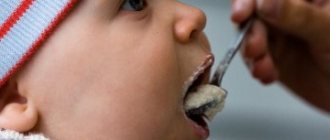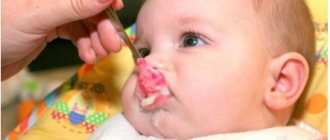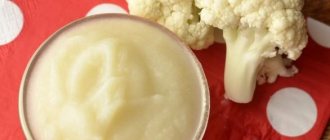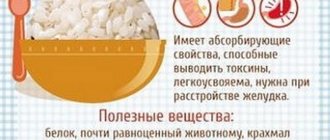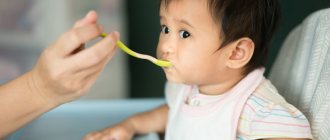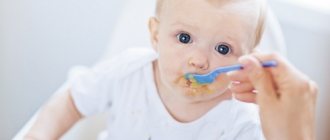There is nothing more valuable and nutritious for a baby than mother's milk. But after some time, breast milk alone becomes insufficient for his rapidly growing needs. At this time, it is necessary to introduce the first complementary foods, introducing the child to new types of food. Pediatricians recommend starting complementary feeding with vegetables or cereals, which effectively saturate the baby’s body with essential microelements and vitamins. The first cereals that a baby is introduced to at the initial stage of complementary feeding are rice, buckwheat and corn. According to the recommendations of many pediatricians, rice porridge for infants should be one of the first to be introduced, and there is every reason for this.
Why is rice porridge good for your baby?
Before introducing any complementary foods to your child, you need to consider the benefits and harms that this product brings with it. The number of beneficial properties of rice outweighs the possible negative consequences. Rice is extremely rich in essential microelements and vitamins. That is why rice porridge for the first feeding stimulates the growth and development of the baby.
So, the beneficial properties of rice:
- First of all, it should be noted that rice does not contain gluten, a vegetable protein that causes various allergic reactions in a child under one year old.
- Rice groats are a rich source of vitamins B and E, which have a great impact on the development of the nervous system, brain functioning, participate in metabolism, improve blood circulation and contribute to the strengthening and growth of hair and nails. All this is undoubtedly important for a growing baby.
- Rice is the only representative of cereals that immediately contains 8 essential amino acids involved in the formation of new cells in the body.
- Rice grains contain the necessary supply of microelements such as phosphorus, calcium, potassium, iron and zinc. All of them contribute to the correct and healthy development of the newborn.
- The complex carbohydrates that make up rice do an excellent job of restoring the baby’s energy expenditure.
Harmful properties
Any mother should take into account not only the beneficial, but also the harmful effects of the product on the body. Therefore, before choosing rice as your first complementary food, you need to familiarize yourself with the list of not-so-healthy properties of rice:
- Constipation. Rice porridge is absolutely not suitable for daily complementary feeding, as this cereal has a fixative effect. It is recommended to give rice porridge no more than 1-2 times a week, then the baby will be able to avoid constipation and digestive problems.
- Even though rice is considered a low-allergenic grain, exceptions do occur. If an infant has an allergic reaction to rice, this product should be eliminated from his diet for several months.
You can read more about the properties and types of rice in the article “Can nursing mothers eat rice?”
When and how to introduce complementary foods
The first complementary foods should be introduced into the child’s diet no earlier than 6-7 months. Until this time, the baby needs breast milk to satisfy its energy and nutritional needs. The first rice porridge should be cooked only in water and without adding sugar. Start giving porridge with 0.5 teaspoon in the morning. If the child does not show any allergic reactions within 24 hours, the portion can be doubled next time. According to this scheme, it is necessary to gradually increase the amount of rice porridge cooked in water eaten. Under no circumstances should you stop breastfeeding your baby. When you bring the amount of porridge consumed by your baby to the norm for his age, you should replace it with only a few feedings per week.
It is best to start giving your baby rice porridge for breakfast, so you can track his reaction to the product throughout the day. If your baby refuses to eat an unfamiliar type of food, add a little expressed breast milk to the rice porridge. It will be easier for the child to perceive the new product.
When to introduce rice porridge into complementary foods
Before introducing porridge into complementary foods, you need to understand and remember the general scheme for introducing complementary foods to infants.
It is based on the fact that the enzyme base is extremely weak, and the baby is not able to digest a number of foods. The greatest danger is posed by fatty foods. Don't think that these are fried cutlets. Fat is found in everything. In milk, vegetables, fruits, cereals, meat, but its percentage is small. It is difficult for a baby to process fats, both in the intestines and in the liver. If the level of fat in the baby's diet is not observed, the intestines can be disrupted, which will lead to a variety of diseases of the gastrointestinal tract and the whole body.
Thus, the introduction of complementary foods is focused on introducing into the baby’s diet the foods that are easiest to digest and do not require the active work of intestinal enzymes, gradually increasing the pace:
- Zucchini puree. An anti-allergenic product that is easy to digest and prepare.
- Fruit puree. Mostly they start with apple juice.
- Then they make it more complicated - add new vegetables or fruits to the puree. Again, choose those products that are in season and least allergenic. It is better to consult a pediatrician.
- The third product is porridge. Rice, buckwheat and corn. They are light, do not cause allergies, are easy to prepare and contain a lot of useful vitamins and microelements.
- The meat is introduced last.
- The introduction of foods to which allergies often occur, such as citrus fruits, strawberries, plums, etc., into the diet occurs at the age of 2 years.
Additionally : corn porridge for babies - what benefits and harm can it bring to babies?
The process of complementary feeding itself also has features:
- The first time the product is given for testing, no more than one teaspoon, in the morning. During the day, the child is observed to see if there are any allergies (rash, nausea), bloating, problems with stool;
- If the body accepts the new positively, the next day you can give the child 2-3 teaspoons. Under no circumstances should you try to feed your child a full portion at once. An excess of new elements may be perceived negatively. It is necessary to gradually increase the daily amount of food.
Puree rice porridge
Complementary foods begin to be introduced at six months. In case of proper development, the turn of porridge will come by the 7th month. At this time, the body is strong enough and has produced a minimum amount of enzymes to digest adult food.
The exception is children with weight problems, allergies and illnesses. Allergy sufferers and children suffering from serious illnesses are not included in the list of those who can eat according to the generally accepted scheme. Their diet is compiled by pediatricians and nutritionists. Breasts with weight problems are divided into 2 categories - underweight and overweight - and only slightly deviate from the general pattern.
If the child is on the “average” list, rice porridge is introduced into his diet at the age of 6-7 months. After vegetable and fruit purees.
How much porridge should a child eat at one meal?
First of all, it should be noted that your child does not owe anything to anyone. You should not force feed him, as this will only develop a negative reflex to accept any food. Any complementary food is offered when the baby is hungry. If he refuses to eat porridge now, wait a little and after a while offer him complementary foods again.
The average volumes of porridge eaten per meal vary within these limits:
| Age | Amount of porridge |
| 6 months | 150 gr |
| 7 months | 150 gr |
| 8 months | 180 gr |
| 9-12 months | 200 gr |
Do not be alarmed if your child eats significantly less than the specified amount. After all, if he is active, gains weight well, develops normally and plays with pleasure, then there is absolutely nothing to worry about.
How to prepare rice porridge for complementary feeding
Before cooking rice porridge for babies, the cereal must be prepared:
- Sort and rinse the rice.
- Soak for 15-20 minutes in water at room temperature.
- Rinse the cereal thoroughly in cold water until it is clean.
These simple steps help rid the rice grains of dust and dirt, and you will be sure that you have prepared a truly healthy porridge for your child.
For the first feeding you should cook 5% porridge, i.e. 5 grams of cereal per 100 ml of water.
Rice flour porridge
This rice flour porridge for babies is suitable for those children who have just begun to get acquainted with porridge and still have a weak chewing reflex.
Ingredients: 20 grams of rice cereal, 250 ml of filtered boiled water.
Preparation: Grind the rice in a coffee grinder until it becomes flour. Pour clean water at room temperature into the rice flour and mix thoroughly. This tender porridge should be cooked for 5-6 minutes. Cool and give it to your baby carefully.
Puree whole grain rice porridge
How to prepare rice porridge for a baby if the first feeding is already over? If the baby is more than 6 months old, his first teeth have already erupted, and he copes well with chewing simple soft food, then you can prepare him porridge with breast milk
Ingredients: 1 tbsp. rice cereal, 1 glass of filtered water, 0.5 glass of breast milk.
Preparation: Prepare the rice using the above method, fill it with water and cook. When the water boils, reduce the heat and cook the rice for another 15-20 minutes until cooked. After the specified time, add breast milk to the pan and cook, stirring constantly, until the porridge thickens - about another 15 minutes. Turn off the burner, cover the pan with a lid and let it brew for another 15-20 minutes. Now grind the porridge using a blender or rub through a sieve. Bring the finished puree with boiled water to the desired consistency.
Rice porridge with fruits or vegetables
When you introduce vegetables and fruits into complementary foods, you can use them to diversify the taste of the porridge. The best options would be unsweetened apples, pumpkin or carrots. Do not add all the fruits and vegetables at once; just one ingredient will be enough to make the porridge even more tasty and healthy. Rinse the food thoroughly with running water, finely chop and grind together with the cooked rice.
Banana and apricot are perfect complements to rice porridge. But pears strengthen the chair, just like rice, so it’s better not to cook them together. Apples are rich in iron, which does not combine with milk, so they should only be added to dairy-free cereals.
Cook your own rice porridge
If mothers cannot or do not want to feed their child store-bought cereals, there is only one way out - to cook it yourself. The baby cannot eat whole grain porridge. He can only swallow a homogeneous mass.
The important point is to choose the right rice. Brown rice is recommended - its bran shell retains the maximum amount of nutrients. This grain is perfect for making rice flour at home. You can give preference to coarse-grained round rice. It boils well and grinds easily, which is why it is used to make porridge for children who are able to swallow micro-lumps.
Before cooking, the rice is thoroughly washed until the sticky liquid is completely removed. Long grain must be poured with boiling water and rinsed with cold water. Only pure rice can be cooked for babies , regardless of the recipe - whole grains or flour.
It is not recommended to give sugar to children under one year of age. If desired, it can be replaced with glucose or fructose.
Additionally : about the introduction of oatmeal into children's menus - read here.
Milk porridge with rice
For babies aged 7-8 months, you can prepare pureed rice porridge. The cooking recipe involves boiling whole grains and then grinding them until smooth. It is not recommended to make milk porridges exclusively with milk for up to a year. It is very fatty, even store-bought, with the least amount of fat in its composition. Typically, the liquid component of cereals is diluted in a 1:1 ratio of water and milk. Thus, the child receives a light milk porridge.
Recipe for pureed rice porridge with milk:
- rice (round) - ½ cup;
- water - 1 glass;
- milk (goat - more about it, cow's milk) - 1 glass.
Procedure:
- Pour the washed rice with water and put on fire, bring to a boil and cook for 5-7 minutes over medium heat. Reduce heat and simmer over low heat for about 15 minutes.
- Add milk, and stirring constantly, cook for 10-15 minutes until thickened.
- Let the finished rice sit, covered, for about 10 minutes. This will make it softer.
- Place the steamed rice in portions in a fine sieve (not a colander) and wipe into a plate using a tablespoon. The portions should not be large, otherwise it will be inconvenient to wipe. Collect the pureed porridge from the outside of the sieve into a plate, add a new portion and wipe again.
- The result is pureed porridge for babies (too thick, dilute with water).
Rice flour porridge
This porridge is recommended for children who are just getting acquainted with solid food and the swallowing process is difficult for them.
Rice flour is made from washed and dried whole rice in a coffee grinder.
Porridge recipe:
- rice flour - 1.5 tbsp. l.;
- water - 1 glass;
- milk - ½ cup;
Procedure:
- Add rice flour to boiling, salted water and cook for about 15 minutes.
- Pour in hot milk and cook for 5 minutes.
- You can add 1 tsp. butter, let cool.
Porridge with cottage cheese
Rice porridge can “hide” cottage cheese, which not all children agree to eat in its pure form. It not only masks the appearance, but also interrupts the sour taste. To add sweetness, sugar is replaced with fructose or glucose.
The recipe is simple - prepare pureed porridge or porridge from flour, add cottage cheese, sweets, mix thoroughly and give it to the child - about introducing cottage cheese into complementary foods.
Let's sum it up
Rice is undoubtedly a very healthy and valuable nutritious product that must be included in the diet of a growing baby. If the child is not one of the small percentage of children who are allergic to the protein contained in rice, this porridge can be offered to the baby without any fear. Now you know how to cook rice porridge for babies correctly. When choosing a method for preparing rice porridge, every mother should first of all focus on the individual characteristics of her baby.
Useful properties of rice
Cereal complementary feeding traditionally begins with dairy-free rice porridge. Along with buckwheat and corn, it is a gluten-free cereal, therefore it is a hypoallergenic product and suitable for feeding babies.
Rice porridge has the following positive properties:
- The balanced composition of essential nutrients makes rice easily digestible and nutritious;
- The rich vitamin and mineral composition ensures harmonious mental and physical development;
- Rice contains 7 essential amino acids, including tryptophan, which is necessary for the functioning of the nervous system and has a calming effect;
- The enveloping properties of rice help improve digestion and protect the baby’s intestinal wall;
- The absorbent effect of rice ensures the removal of toxins from the body;
- The substances contained in rice promote the growth of muscle tissue.
In addition to its composition, another positive quality of rice is its taste. The structure of the rice porridge is tender and homogeneous, it is easy to swallow. Children usually eat it with pleasure.
